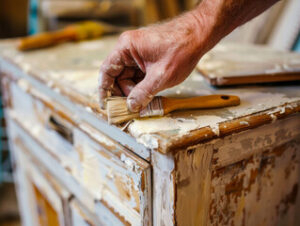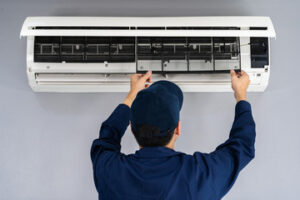A well-designed gutter system safeguards your home from water damage and improves its resale value. However, a poorly designed gutter setup can result in costly leaks and structural problems.

Gutter Installation Murfreesboro TN is a major undertaking that requires accurate measurements and precise mounting. This ensures that rainwater flows smoothly toward the downspouts.
Gutter installation is an important project that safeguards your home’s structural integrity and prevents future damage to your roof and landscaping. The best gutter systems are made from quality materials that last several years, sparing you costly repair bills.
When it comes to choosing a gutter system, you must consider your home’s architectural features and local weather conditions. For example, steep roofs require bigger gutters than flat ones. Additionally, if your area experiences heavy rain or snowfall, you should opt for a gutter system that can withstand these elements.
Also, make sure you choose a gutter system with downspouts to facilitate efficient water runoff. The downspouts should drain into a lower gutter so that the water doesn’t flow directly onto your roof.
Finally, don’t forget to invest in the right tools for your gutter installation project. You’ll need a ladder and some basic safety gear, such as a harness or helmet, to safely access your roofline. In addition, a sheet metal notcher or a set of tin snips are essential for making the proper cuts needed for your gutter system to fit perfectly on your home. Lastly, a roofing contractor has a range of other tools and accessories that can help ensure a seamless, high-quality gutter installation.
Assess Your Gutters’ Needs
Gutters may be out of sight and out of mind, but they play a vital role in protecting your home from water damage. It’s important to check your gutters regularly for signs of damage, including hail marks, cracking, discoloration and loose sections. If you’re planning on selling your home soon, it’s also important to fix any issues with your gutter system before prospective buyers tour the property.
Gutter systems are designed to direct rainwater and snow melt away from your roofline, preventing sagging, warping and structural problems. But a poorly installed or undersized gutter system can lead to ongoing maintenance headaches and costly repairs.
The first step in assessing your gutters’ needs is to measure the length of your roofline. Using a sturdy ladder with a stabilizer attachment, climb up to the gutter level and extend your measuring tape from one end to the other.
Select the Right Material
Gutters protect your home’s foundation, roofline, and landscaping from water damage. They also add to your home’s visual appeal, making them a great addition to many architectural styles. However, not all gutter systems are created equal. The type of material you choose is one key factor impacting the performance, longevity, and aesthetics of your gutter system.
Different gutter materials offer unique benefits, from cost-effectiveness to rust resistance. Additionally, they are available in a range of colors, giving you plenty of options to match your home’s aesthetic preferences. However, your local climate will also play a role in the choice you make. For example, colder areas may require gutter systems with increased structural integrity to prevent ice dams and corrosion.
When selecting the right gutter system, it’s important to take accurate measurements to ensure that your gutters are sized correctly. An undersized gutter can lead to overflow during storms and cause water damage to your home’s foundation and siding. Using a tape measure, ladder, and a level to make sure your measurements are precise is essential. Additionally, you should also consider the number of downspouts your gutter system needs. Generally, homes with less square footage need 5 gutters, while those with more should have 6. A professional can help you determine the best gutter size for your home’s unique needs.
Measure Your Roofline
The gutters collect water runoff from the roof and direct it away from the home’s foundation, siding, landscaping, and basement to prevent mold, damage, and erosion over time. Considering how crucial they are to your home’s safety and structural integrity, it is important that you hire a professional for the installation process.
The first step in the installation timeline is to measure your roofline. It is important that the measurements are accurate, since the gutters will have to be made to fit your house. This will reduce the installation time and also ensure that your gutters are well-fitted and work efficiently.
A reputable roofing specialist will use a ladder or scaffolding to get the necessary dimensions. They will also take into consideration the type of roof structure, as flat roofs present unique challenges and require special attention when it comes to gutter installation.
Gutter installation should be done in dry weather to avoid interference from runoff. It is also a good idea to inspect the fascia before the installation, and replace any rotten wood. A professional should also check the downspout location and inclination to ensure that they are draining properly. Downspouts should be positioned 4 to 6 feet away from the foundation to avoid water intrusion and seepage.
Install the Gutters
A gutter system protects your roofline, walls, windows, foundation, and other parts of your house from damage. Without it, water would fall down your roofline and cause rot or mildew. Water can also splash against your home, soaking the sides of the foundation and potentially causing a lot of moisture in the walls and ceilings. These damages can cost you thousands of dollars in repairs. Gutter installation is a relatively simple process that can save you money and prevent costly future repairs.
When installing your gutters, make sure they are properly spaced and aligned with the fascia brackets. Also, ensure that the gutters have a proper slope to facilitate efficient rainwater runoff and direct it away from your building’s foundation. You should also clear any overhanging trees and shrubs that could impede the flow of water from your gutters.
The last step is to install the downspouts, which are pipes that carry rainwater from the gutters and divert it from your foundation. To do this, you will need to mark the position of each downspout on your guttering and then cut the holes using tin snips. You will also need to install the downspout tubes and connect them to your gutters with the help of rivets and machine screws.
Seal the Gutters
If you are doing gutter installation yourself, make sure to use a good quality silicone sealant. This will not only prevent leaks but also protect the integrity of the gutter system by stopping moisture from entering and damaging the roof structure or foundations.
Gutters are long channels that run along the lower edge of a roofline. They direct rainwater towards downspouts, preventing water accumulation that could damage the building’s foundations. Gutters should be hung with a slope of about 1/4 inch per 10 feet, to ensure that rainwater drains properly and does not clog the gutters.
To complete a proper gutter installation, add end caps, elbow joints, and downspout extensions to the channel, and seal them well. Also, install downspout anchor straps or brackets to help secure the gutters.
Before you apply the sealant, clean the area where the gutters will be sealed with a power washer or scraper to remove dirt, grime, and debris that may interfere with the creation of a watertight seal. Once the gutter is clean and dry, apply a thick bead of the waterproof caulk to the seam or joint, and smooth it with your finger or a tool. Allow the caulk to cure according to manufacturer instructions before exposing it to water.
Regular Inspections
Gutters serve an important function by channeling rainwater away from a building’s foundation, but they can overflow if they’re clogged or improperly installed. Regular inspections by trained professionals are the best way to ensure that your gutter system is functioning properly and protecting your property.
A home inspector will look at the physical condition of your gutters and downspouts, examining for cracks, rust, sagging, and any other damage that may need to be addressed. He will also check for clogs and blockages, including the accumulation of leaves, twigs, and other debris that can hinder water flow. He will also ensure that your gutters have the proper slope and are adequately aligned with downspouts to prevent standing water or overflow.
In addition to checking for signs of clogging and obstructions, home inspectors will also look at the seams and joints to identify any leaks or other problems that need to be repaired. Leaking gutters can lead to moisture intrusion, which can cause structural and rot damage, mold growth, peeling paint, and staining on the siding and roof of your home. Having your gutters regularly inspected and cleaned can extend their lifespan and protect your home’s value, curb appeal, and safety.








